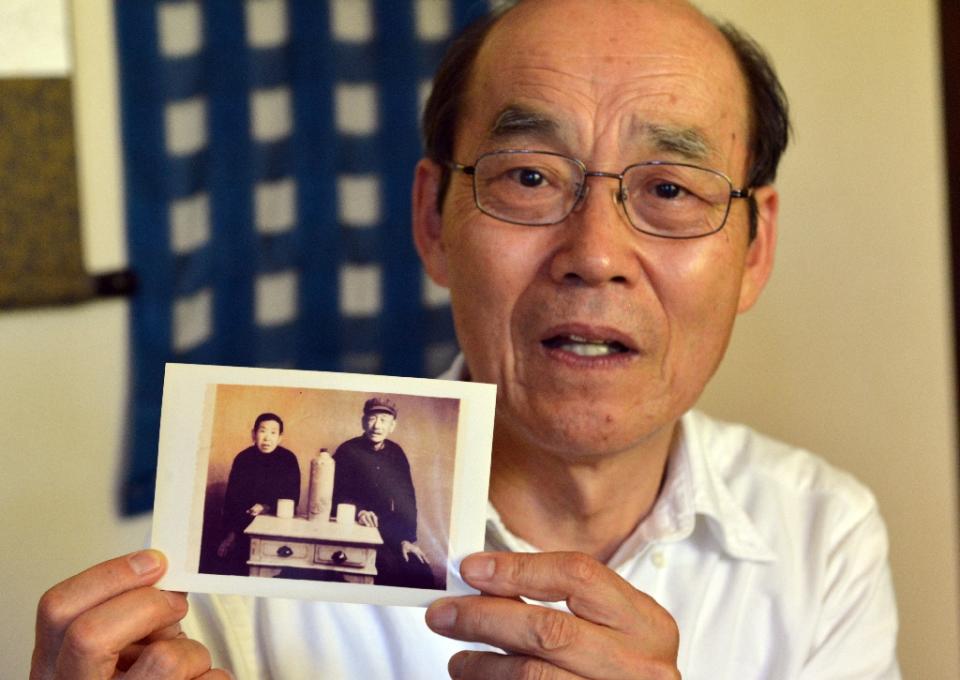
Now 73 and sitting in his Tokyo home, Yohachi Nakajima fights back tears when he thinks of his Chinese adopted mother and the farming village he once called home -- a boy lost inside imperial Japan's crumbling empire.
He was just three years old when Tokyo surrendered on August 15, 1945, ending World War II but also leaving about 1.5 million Japanese stranded in Manchukuo, Tokyo's puppet regime in northeastern China.
Farmers, labourers and young military reserves had migrated into the region from the early 1930s, attracted by government promises of a better life as Japan marched across Asia in a brutal expansionist campaign.
Nakajima's father, Hiroshi, was among those drawn to Manchukuo, but the frontier life proved miserable and the elder Nakajima was drafted into the military just three weeks before Japan's surrender. His fate is unknown.
Ill and poverty-stricken, Nakajima's mother sought out a local family to care for her son.
"Japan was an invader for them, clearly," Nakajima, who now lives in Tokyo, told AFP.
"It must have been pure humanity that convinced them to adopt and raise me, a child of the aggressor."
The malnourished boy, stomach bulging from starvation, was brought into the centre of the village as curious locals looked on.
One woman, Sun Zhenqin, volunteered to be his guardian and soon gave her scrawny charge a new name, "Lai Fu" (good luck coming).
"She would feed me from her mouth and gently massaged my stomach," Nakajima said.
"She was a midwife. It must have been almost on impulse that she took me in."
- 'Pearl in the palm' -
After Emperor Hirohito announced his country's surrender, the situation for Japanese migrants trapped in northeastern China deteriorated, with tens of thousands dying of hunger and disease as a frigid winter set in later in the year.
Some migrants-turned-refugees resorted to mass suicide, cramming into small houses that they blew up with grenades, while roving groups of sword-wielding male migrants stabbed women and children to death to end their suffering.
It is believed that just a handful of children were adopted by local families. Many others died of starvation, sickness and some were even killed by fellow Japanese out of mercy. There are no reliable statistics on how many survived.
The mother of Sun Shouxun, 58, a Chinese man who now lives in the northeastern city of Changchun, was one of those who took in a Japanese child.
He described his adopted Japanese sister as "a pearl in the palm" for his loving parents.
"Public opinion at the time was rather strong against raising a Japanese child and our relatives also opposed it, but my mother insisted on doing so," he said.
It is not known exactly how many Japanese children found new homes in China like Nakajima and Sun's sister, but Tokyo has confirmed just over 2,800.
Nakajima returned to Japan when he was 16 and afterwards spoke just once with his adopted mother, in 1966, during a trip to China when he acted as an interpreter on a cultural exchange.
However, the country, by then in the grips of the chaotic Cultural Revolution, was largely closed to foreigners and Nakajima only made brief contact by telephone with Sun who could only shout "Lai Fu! Lai Fu!" before the call got cut off.
The two never talked again and Sun died in 1975.
- 'No phone calls, no letters' -
Tokyo's efforts to repatriate those left behind in China only began several years after 1972, when it normalised diplomatic ties with Beijing.
Children were not the only ones missing -- there were also young women who had been dispatched as "bride candidates" to marry migrants.
Fumiko Nishino, 88, was one of them, although the official reason she moved to Manchukuo, along with her two sisters, was to work as a telephone operator.
The trio eventually found passage home, but Nishino, who had twin baby girls with a Chinese soldier by that time, refused to board the ship.
"I lost contact -- no phone calls, no letters -- with my Japanese family for years and years afterwards," she said.
"When I finally returned home to Japan (in the mid-1970s) there was a grave that said I was dead at 19.
"I pushed over the gravestone and destroyed it, crying and laughing at the same time with my family."
Japan's welfare ministry said just over 4,150 women like Nishino returned home while many others make occasional visits.
Reimei Sakuma, 72, was the child of a Japanese soldier. Adopted and raised in a Chinese family, he returned to Japan in 1986 and also found his name on a gravestone raised by his Japanese relatives -- in part due to government policy.
In 1959, Japan declared that nearly 20,000 Japanese left overseas since the war -- mostly in China -- were dead or did not intend to return -- abandoning them for a second time.
"I could only feel helpless and at the mercy of two big powers," Sakuma said of his experience.
The legacy of the war still strains diplomatic ties between Tokyo and Beijing. China says more than 20 million of its citizens died as a result of Japan's invasion, occupation and atrocities.
Nakajima was one of the lucky ones. He reunited with his birth mother, who had also made it back home, and they remained close until her death at 98.
But the kindness of Sun and other villagers is one of the memories forever etched on Nakajima's mind, along with working in the fields and coming home to a steaming plate of potatoes.
"What if the situation had been the other way around? I wonder if the Japanese would have acted the same way," he said. afp








































